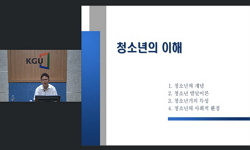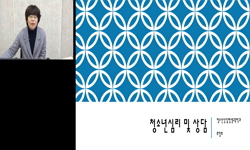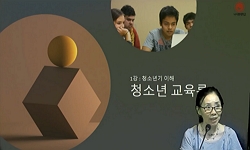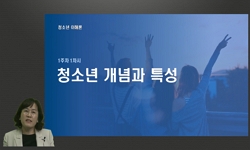This study aims to develop the content and methods of reading education for Bokseonhwaumga through gender literacy. Gender literacy is defined as a practical ability to critically reflect on the relationship between embodied gender norms and the corre...
http://chineseinput.net/에서 pinyin(병음)방식으로 중국어를 변환할 수 있습니다.
변환된 중국어를 복사하여 사용하시면 됩니다.
- 中文 을 입력하시려면 zhongwen을 입력하시고 space를누르시면됩니다.
- 北京 을 입력하시려면 beijing을 입력하시고 space를 누르시면 됩니다.
젠더 리터러시를 통한 〈복선화음가〉 읽기 교육 연구 = An Educational Study on Reading Bokseonhwaeumga Through Gender Literacy
한글로보기https://www.riss.kr/link?id=T17244067
- 저자
-
발행사항
서울 : 서울대학교 대학원, 2025
-
학위논문사항
학위논문(석사) -- 서울대학교 대학원 , 국어교육과 국어교육전공 , 2025. 2
-
발행연도
2025
-
작성언어
한국어
- 주제어
-
DDC
410.7
-
발행국(도시)
서울
-
형태사항
ⅶ, 187 ; 26 cm
-
일반주기명
지도교수: 고정희
-
UCI식별코드
I804:11032-000000188481
- DOI식별코드
- 소장기관
-
0
상세조회 -
0
다운로드
부가정보
다국어 초록 (Multilingual Abstract)
Chapter II establishes the specific theoretical framework for the study. First, Section 1 examines the relationship between gender literacy and critical literacy, as well as the concepts of gender and the body, in order to define the concept of gender literacy emphasized in this research. Both gender literacy and critical literacy share reading stages that involve recognition, critique, and practice, and critical awareness of the relationship between language and power. However, the reasons for establishing gender literacy as a distinct concept in this study are as follows: 1) the necessity of considering the existential characteristics of gender, 2) the goal of fostering learners' critical thinking through a critical awareness of gender, and 3) addressing the lack of emotional engagement, which is often identified as a limitation of critical literacy. Subsequently, this study examined the gender discussions of Butler's epistemological feminism, which emphasizes social construction, and material feminism, which underscores the body that traverses the boundaries of cognition and existence, highlighting the multi-layered and complex nature of gender. This is because the gender perceived by adolescent learners is experienced through language and the body, making it both cognitive and existential. Accordingly, the study examines the concept of the 'body' as articulated by Merleau-Ponty, Grosz, and Braidotti. The body embodies an individual’s specific daily life, context, position, and experiences, generating multiple and complex differences. In Section 2, the study discusses the components of gender literacy—gender norms, gender performance, and gender consciousness—based on the points where gender issues become prominent in reading Bokseonhwaumga. Gender norms are defined as ‘socially constructed and enforced gender rules or roles,’ gender performance as ‘acts and speech that conform to or subvert embodied gender norms,’ and gender consciousness as ‘a meta-awareness and critical consciousness of gender norms and gender performance.’In Section 3, the study delineates three stages of reading Bokseonhwaumga through gender literacy: 1) recognizing gender elements in the text through embodied gender literacy, 2) critiquing the socio-constructivist and binary gender structures within the text, and 3) fostering learners' identity reflection and personal and social praxis. Literary works and gender literacy share a mutually constitutive relationship and are processes that are constantly evolving.
In Chapter III, based on the theoretical foundation established earlier, an experiment was designed to analyze how learners read Bokseonhwaumga through gender literacy. First, learners identified the patriarchal gender norms present in Gyeonyega (didactic songs for women), critically examined the relationship between macro- and micro-level power structures and gender norms, and reflected on their own gender norms. Second, learners recognized gender performance through the language and flesh of the characters in Bokseonhwaumga, critiqued whether these performances conformed to or subverted established norms, and demonstrated praxis by adapting their own gender performances based on their critique of the characters’ performances. Third, learners identified the relationship between the characters' gender consciousness and the progression of the text, critically examined the formation of both the characters’ and their own gender consciousness, and sought ways to expand their gender consciousness into personal and social praxis. These findings illustrate how learners engaged with Bokseonhwaumga through a multilayered reading facilitated by gender literacy. However, some learners faced difficulties in reading Bokseonhwaumga through gender literacy. They showed a passive attitude toward identifying the components of gender literacy, uncritically accepted power-imbalanced gender norms and performances, or failed to expand ethical gender consciousness into their lived contexts. This study identified these limitations and aimed to propose educational content and methods to address them effectively.
Therefore, in Chapter IV, based on the above discussions, a specific design for reading Bokseonhwaumga through gender literacy was developed. First, in Section 1, the goals of reading Bokseonhwaumga through gender literacy were set as follows: 1) recognizing the value of Bokesonhwaumga as a text that embodies multilayered gender, 2) fostering critical readers through the enhancement of literacy skills, and 3) laying the foundation for ethical practice by cultivating gender sensitivity. To achieve these goals, Section 2 outlines the content of reading Bokseonhwaumga through gender literacy, which includes: 1) recognizing the historical context of gender norms in the Joseon Dynasty and the Gyeonyega tradition, 2) forming critical thinking and alternative perspectives based on gender, and 3) fostering ethical consciousness through the exploration of the diversity of body and gender identity. Finally, in Section 3, the study presents methods for teaching "Bokseonhwaumga" through gender literacy as a practical approach to implementing the educational content were presented, which include: 1) critical discussions on gender norms through intertextual comparisons, 2) writing continuation of Bokseonhwaumga by linking the learner’s identity with the characters, and 3) exploring the modern reinterpretation of Bokseonhwaumga and ethical community through visual expression.
This study demonstrates that learners can move beyond the fragmented and binary interpretations to read Bokseonhwaumga in a multilayered manner through gender literacy. Through gender literacy, learners can read Bokseonhwaumga and become active participants in interpreting and reimagining classical literature, engaging deeply with its dynamic language and body. The educational approach proposed by this study is significant in that it allows learners to reflect on their own identities and social contexts, rediscover the modern value of classical literature, and develop into autonomous and ethical readers.
This study aims to develop the content and methods of reading education for Bokseonhwaumga through gender literacy. Gender literacy is defined as a practical ability to critically reflect on the relationship between embodied gender norms and the corresponding performance of gender, and consciously recognize a positive self-identity to aim for the practical ability to pursue an ethical community. This study critiques the dichotomous interpretation of female narrators in classical Korean poetry education as either ‘passive women’ or ‘active women’. The gender performance of the characters in the Joseon Dynasty's Gyenyeogaryu Gyubanggasa Bokseonhwaumga, which embodies gender norms of that era, is intertwined with various gender-related elements that cannot be confined to polarized interpretative frameworks. Therefore, this study aims to design reading education for adolescent learners to read Bokseonhwaumga in a multi-layered and complex manner through gender literacy.
Chapter II establishes the specific theoretical framework for the study. First, Section 1 examines the relationship between gender literacy and critical literacy, as well as the concepts of gender and the body, in order to define the concept of gender literacy emphasized in this research. Both gender literacy and critical literacy share reading stages that involve recognition, critique, and practice, and critical awareness of the relationship between language and power. However, the reasons for establishing gender literacy as a distinct concept in this study are as follows: 1) the necessity of considering the existential characteristics of gender, 2) the goal of fostering learners' critical thinking through a critical awareness of gender, and 3) addressing the lack of emotional engagement, which is often identified as a limitation of critical literacy. Subsequently, this study examined the gender discussions of Butler's epistemological feminism, which emphasizes social construction, and material feminism, which underscores the body that traverses the boundaries of cognition and existence, highlighting the multi-layered and complex nature of gender. This is because the gender perceived by adolescent learners is experienced through language and the body, making it both cognitive and existential. Accordingly, the study examines the concept of the 'body' as articulated by Merleau-Ponty, Grosz, and Braidotti. The body embodies an individual’s specific daily life, context, position, and experiences, generating multiple and complex differences. In Section 2, the study discusses the components of gender literacy—gender norms, gender performance, and gender consciousness—based on the points where gender issues become prominent in reading Bokseonhwaumga. Gender norms are defined as ‘socially constructed and enforced gender rules or roles,’ gender performance as ‘acts and speech that conform to or subvert embodied gender norms,’ and gender consciousness as ‘a meta-awareness and critical consciousness of gender norms and gender performance.’In Section 3, the study delineates three stages of reading Bokseonhwaumga through gender literacy: 1) recognizing gender elements in the text through embodied gender literacy, 2) critiquing the socio-constructivist and binary gender structures within the text, and 3) fostering learners' identity reflection and personal and social praxis. Literary works and gender literacy share a mutually constitutive relationship and are processes that are constantly evolving.
In Chapter III, based on the theoretical foundation established earlier, an experiment was designed to analyze how learners read Bokseonhwaumga through gender literacy. First, learners identified the patriarchal gender norms present in Gyeonyega (didactic songs for women), critically examined the relationship between macro- and micro-level power structures and gender norms, and reflected on their own gender norms. Second, learners recognized gender performance through the language and flesh of the characters in Bokseonhwaumga, critiqued whether these performances conformed to or subverted established norms, and demonstrated praxis by adapting their own gender performances based on their critique of the characters’ performances. Third, learners identified the relationship between the characters' gender consciousness and the progression of the text, critically examined the formation of both the characters’ and their own gender consciousness, and sought ways to expand their gender consciousness into personal and social praxis. These findings illustrate how learners engaged with Bokseonhwaumga through a multilayered reading facilitated by gender literacy. However, some learners faced difficulties in reading Bokseonhwaumga through gender literacy. They showed a passive attitude toward identifying the components of gender literacy, uncritically accepted power-imbalanced gender norms and performances, or failed to expand ethical gender consciousness into their lived contexts. This study identified these limitations and aimed to propose educational content and methods to address them effectively.
Therefore, in Chapter IV, based on the above discussions, a specific design for reading Bokseonhwaumga through gender literacy was developed. First, in Section 1, the goals of reading Bokseonhwaumga through gender literacy were set as follows: 1) recognizing the value of Bokesonhwaumga as a text that embodies multilayered gender, 2) fostering critical readers through the enhancement of literacy skills, and 3) laying the foundation for ethical practice by cultivating gender sensitivity. To achieve these goals, Section 2 outlines the content of reading Bokseonhwaumga through gender literacy, which includes: 1) recognizing the historical context of gender norms in the Joseon Dynasty and the Gyeonyega tradition, 2) forming critical thinking and alternative perspectives based on gender, and 3) fostering ethical consciousness through the exploration of the diversity of body and gender identity. Finally, in Section 3, the study presents methods for teaching "Bokseonhwaumga" through gender literacy as a practical approach to implementing the educational content were presented, which include: 1) critical discussions on gender norms through intertextual comparisons, 2) writing continuation of Bokseonhwaumga by linking the learner’s identity with the characters, and 3) exploring the modern reinterpretation of Bokseonhwaumga and ethical community through visual expression.
This study demonstrates that learners can move beyond the fragmented and binary interpretations to read Bokseonhwaumga in a multilayered manner through gender literacy. Through gender literacy, learners can read Bokseonhwaumga and become active participants in interpreting and reimagining classical literature, engaging deeply with its dynamic language and body. The educational approach proposed by this study is significant in that it allows learners to reflect on their own identities and social contexts, rediscover the modern value of classical literature, and develop into autonomous and ethical readers.
국문 초록 (Abstract)
이를 위해 Ⅱ장에서 구체적인 이론적 배경을 마련하였다. 먼저, 1절에서 본 연구가 강조하는 젠더 리터러시의 개념을 설정하기 위해 젠더 리터러시와 비판적 리터러시와의 관계, 젠더와 몸의 개념을 살폈다. 젠더 리터러시와 비판적 리터러시는 언어와 권력의 관계에 대한 비판적 인식, 그리고 인지, 비판, 실천을 거치는 읽기 단계를 공유한다. 하지만, 본 연구에서 젠더 리터러시를 별도로 설정하는 이유는 1) 젠더가 갖는 실존적인 특성을 고려할 필요성, 2) 젠더에 대한 비판적 인식을 통해 학습자의 비판적 사고를 발달하고자 하는 목표, 3) 비판적 리터러시의 한계로 지적되는 감정 부재의 해결에 있다. 이후 본 연구는 사회구성적인 영향을 강조한 버틀러(Butler)의 인식론적 페미니즘과 인식과 실존의 경계를 넘나드는 ‘몸’을 강조한 유물론적 페미니즘(Material Feminism)의 젠더 논의를 함께 검토하며 젠더가 갖는 다층성과 복잡성을 강조했다. 청소년 학습자들이 인지하는 젠더는 언어와 신체를 통해 경험되는 것으로, 인식적이고 동시에 실존적인 것이기 때문이다. 본 연구는 메를로-퐁티(Merleau-Ponty)부터 그로츠(Grosz), 그리고 브라이도티(Braidotti)로 이어지는 ‘몸’의 개념을 검토하였다. 몸은 개인의 구체적인 일상·맥락·위치·경험이 체화되며, 다중적이며 복합적인 차이들을 생성하는 것이다. 다음으로 2절에서는 젠더 리터러시를 통한 <복선화음가> 읽기에서 젠더 문제가 부각되는 지점에 따라 젠더 러터리시의 구성 요소를 젠더 규범, 젠더 수행, 젠더 의식으로 나누어 논의했다. 본 연구의 젠더 규범은 ‘사회적으로 구성되어 강제된 젠더 규칙 혹은 젠더 역할’, 젠더 수행은 ‘체화한 젠더 규범에 순응, 혹은 전복하는 방식의 말과 행위’, 젠더 의식은 ‘젠더 규범과 젠더 수행에 대한 메타적·비판적 의식’이다. 이후 3절에서는 젠더 리터러시를 통한 <복선화음가> 읽기의 단계를 1) 체화된 젠더 리터러시를 통한 텍스트의 젠더 인지, 2) 텍스트의 사회구성적·이분법적 젠더에 대한 비판, 3) 학습자의 정체성 성찰과 개인적·사회적 실천으로 설정하였다. 문학 작품과 젠더 리터러시는 상호구성적인 관계에 있으며, 끊임없이 변화하는 과정 그 자체이다.
Ⅲ장에서는 이상의 이론적 기반을 토대로 실험을 설계하여, 학습자가 젠더 리터러시를 통해 <복선화음가>를 읽는 양상을 분석하였다. 첫째, 학습자들은 계녀가사의 가부장적 젠더 규범을 인지하고, 거시적·미시적 권력 구조와 젠더 규범의 관계에 대해 비판하고, 학습자의 젠더 규범에 대해 성찰하였다. 둘째, 학습자들은 복선화음가 속 인물의 언어와 신체를 통해 젠더 수행을 인지하고, 인물의 규범 순응적·전복적인 젠더 수행을 비판하고, 인물의 젠더 수행에 근거하여 학습자의 젠더 수행이 변화하는 양상을 보여주었다. 셋째, 학습자들은 인물의 젠더 의식과 텍스트 전개의 관계를 인지하고, 인물과 학습자의 젠더 의식 형성에 대해 비판하고, 학습자의 젠더 의식 확장을 통해 개인적·사회적 실천을 모색하였다. 이와 같이 학습자들은 젠더 리터러시를 통해 <복선화음가>를 다층적으로 읽어내는 모습을 보였다. 하지만 일부 학습자의 경우, 젠더 리터러시를 통해 <복선화음가>를 읽을 때 어려움을 겪기도 하였다. 젠더 리터러시의 구성 요소 발견에 대한 소극적 태도를 보이거나, 권력 불균형적 젠더 규범과 젠더 수행을 무비판적으로 수용하거나, 삶의 맥락으로 윤리적인 젠더 의식을 확장하지 못한 경우가 있었다. 본 연구는 이러한 한계점들을 파악하고, 이를 해결할 수 있는 교육 내용과 방법을 마련하고자 하였다.
따라서 Ⅳ장에서는 이상의 논의에 기반하여 젠더 리터러시를 통한 <복선화음가> 읽기 교육을 구체적으로 설계하였다. 먼저 1절에서 젠더 리터러시를 통한 <복선화음가> 읽기 교육의 목표를 1) 다층적인 젠더가 구현된 <복선화음가>의 가치 인식, 2) 리터러시 역량 강화를 통한 비판적 주체로의 성장, 3) 젠더 감수성 함양을 통한 윤리적 실천의 기반 마련으로 설정하였다. 이를 위해 2절에서는 젠더 리터러시를 통한 <복선화음가> 읽기 교육의 내용으로 1) 조선 시대 젠더 규범과 계녀가사의 역사적 맥락 인식, 2) 젠더에 기반한 비판적 사고와 대안적 시각 형성, 3) 몸과 젠더 정체성의 다양성 탐구를 통한 윤리의식 함양을 설정하였다. 마지막으로 3절에서 교육 내용의 실천을 위해 젠더 리터러시를 통한 <복선화음가> 읽기 교육의 방법으로 1) 상호텍스트 비교를 통한 젠더 규범의 비판적 토론, 2) 학습자의 정체성과 인물의 연결을 통한 <복선화음가> 이어쓰기, 3) 시각적 표현을 통한 <복선화음가>의 현대적 재해석과 윤리적 공동체 탐구를 제안하였다.
본 연구는 기존의 단편적이고 이분법적인 해석을 넘어, 학습자가 젠더 리터러시를 통해 <복선화음가>를 다층적으로 읽어낼 수 있음을 논증하였다. 학습자들은 젠더 리터러시를 통해 <복선화음가>를 읽으며 역동적인 언어와 몸으로 고전을 적극적으로 해석하고 재탄생시키는 고전문학의 향유 주체가 될 수 있다. 본 연구가 제안한 교육은 학습자들이 자신의 정체성과 사회적 맥락을 성찰하며, 고전문학의 현대적 가치를 재발견하고, 주체적이고 윤리적인 독자로 성장할 수 있다는 점에서 의의가 있다.
본 연구는 젠더 리터러시(Gender Literacy)를 통한 <복선화음가> 읽기 교육의 내용과 방법을 마련하는 것을 목적으로 한다. 젠더 리터러시란, ‘개인에게 체화된 젠더 규범과 그에 따른 젠더 ...
본 연구는 젠더 리터러시(Gender Literacy)를 통한 <복선화음가> 읽기 교육의 내용과 방법을 마련하는 것을 목적으로 한다. 젠더 리터러시란, ‘개인에게 체화된 젠더 규범과 그에 따른 젠더 수행의 관계를 비판적으로 성찰하고, 긍정적인 자기 정체성을 주체적으로 의식하여, 윤리적 공동체를 지향하는 실천적 능력’이다. 기존의 고전시가 교육에서 여성 화자에 대한 해석은 ‘수동적인 여성’ 또는 ‘능동적인 여성’으로 단편적으로 양분되었다. 하지만, 조선 시대의 젠더 규범이 구현된 계녀가류 규방가사인 <복선화음가>에 나타나는 인물들의 젠더 수행은 양극화된 해석의 틀에 담길 수 없는 다양한 젠더 관련 요소들이 복합적으로 얽혀있다. 따라서, 본 연구는 청소년 학습자가 젠더 리터러시를 통해 <복선화음가>를 다층적·복합적으로 읽어낼 수 있도록 읽기 교육을 설계하고자 하였다.
이를 위해 Ⅱ장에서 구체적인 이론적 배경을 마련하였다. 먼저, 1절에서 본 연구가 강조하는 젠더 리터러시의 개념을 설정하기 위해 젠더 리터러시와 비판적 리터러시와의 관계, 젠더와 몸의 개념을 살폈다. 젠더 리터러시와 비판적 리터러시는 언어와 권력의 관계에 대한 비판적 인식, 그리고 인지, 비판, 실천을 거치는 읽기 단계를 공유한다. 하지만, 본 연구에서 젠더 리터러시를 별도로 설정하는 이유는 1) 젠더가 갖는 실존적인 특성을 고려할 필요성, 2) 젠더에 대한 비판적 인식을 통해 학습자의 비판적 사고를 발달하고자 하는 목표, 3) 비판적 리터러시의 한계로 지적되는 감정 부재의 해결에 있다. 이후 본 연구는 사회구성적인 영향을 강조한 버틀러(Butler)의 인식론적 페미니즘과 인식과 실존의 경계를 넘나드는 ‘몸’을 강조한 유물론적 페미니즘(Material Feminism)의 젠더 논의를 함께 검토하며 젠더가 갖는 다층성과 복잡성을 강조했다. 청소년 학습자들이 인지하는 젠더는 언어와 신체를 통해 경험되는 것으로, 인식적이고 동시에 실존적인 것이기 때문이다. 본 연구는 메를로-퐁티(Merleau-Ponty)부터 그로츠(Grosz), 그리고 브라이도티(Braidotti)로 이어지는 ‘몸’의 개념을 검토하였다. 몸은 개인의 구체적인 일상·맥락·위치·경험이 체화되며, 다중적이며 복합적인 차이들을 생성하는 것이다. 다음으로 2절에서는 젠더 리터러시를 통한 <복선화음가> 읽기에서 젠더 문제가 부각되는 지점에 따라 젠더 러터리시의 구성 요소를 젠더 규범, 젠더 수행, 젠더 의식으로 나누어 논의했다. 본 연구의 젠더 규범은 ‘사회적으로 구성되어 강제된 젠더 규칙 혹은 젠더 역할’, 젠더 수행은 ‘체화한 젠더 규범에 순응, 혹은 전복하는 방식의 말과 행위’, 젠더 의식은 ‘젠더 규범과 젠더 수행에 대한 메타적·비판적 의식’이다. 이후 3절에서는 젠더 리터러시를 통한 <복선화음가> 읽기의 단계를 1) 체화된 젠더 리터러시를 통한 텍스트의 젠더 인지, 2) 텍스트의 사회구성적·이분법적 젠더에 대한 비판, 3) 학습자의 정체성 성찰과 개인적·사회적 실천으로 설정하였다. 문학 작품과 젠더 리터러시는 상호구성적인 관계에 있으며, 끊임없이 변화하는 과정 그 자체이다.
Ⅲ장에서는 이상의 이론적 기반을 토대로 실험을 설계하여, 학습자가 젠더 리터러시를 통해 <복선화음가>를 읽는 양상을 분석하였다. 첫째, 학습자들은 계녀가사의 가부장적 젠더 규범을 인지하고, 거시적·미시적 권력 구조와 젠더 규범의 관계에 대해 비판하고, 학습자의 젠더 규범에 대해 성찰하였다. 둘째, 학습자들은 복선화음가 속 인물의 언어와 신체를 통해 젠더 수행을 인지하고, 인물의 규범 순응적·전복적인 젠더 수행을 비판하고, 인물의 젠더 수행에 근거하여 학습자의 젠더 수행이 변화하는 양상을 보여주었다. 셋째, 학습자들은 인물의 젠더 의식과 텍스트 전개의 관계를 인지하고, 인물과 학습자의 젠더 의식 형성에 대해 비판하고, 학습자의 젠더 의식 확장을 통해 개인적·사회적 실천을 모색하였다. 이와 같이 학습자들은 젠더 리터러시를 통해 <복선화음가>를 다층적으로 읽어내는 모습을 보였다. 하지만 일부 학습자의 경우, 젠더 리터러시를 통해 <복선화음가>를 읽을 때 어려움을 겪기도 하였다. 젠더 리터러시의 구성 요소 발견에 대한 소극적 태도를 보이거나, 권력 불균형적 젠더 규범과 젠더 수행을 무비판적으로 수용하거나, 삶의 맥락으로 윤리적인 젠더 의식을 확장하지 못한 경우가 있었다. 본 연구는 이러한 한계점들을 파악하고, 이를 해결할 수 있는 교육 내용과 방법을 마련하고자 하였다.
따라서 Ⅳ장에서는 이상의 논의에 기반하여 젠더 리터러시를 통한 <복선화음가> 읽기 교육을 구체적으로 설계하였다. 먼저 1절에서 젠더 리터러시를 통한 <복선화음가> 읽기 교육의 목표를 1) 다층적인 젠더가 구현된 <복선화음가>의 가치 인식, 2) 리터러시 역량 강화를 통한 비판적 주체로의 성장, 3) 젠더 감수성 함양을 통한 윤리적 실천의 기반 마련으로 설정하였다. 이를 위해 2절에서는 젠더 리터러시를 통한 <복선화음가> 읽기 교육의 내용으로 1) 조선 시대 젠더 규범과 계녀가사의 역사적 맥락 인식, 2) 젠더에 기반한 비판적 사고와 대안적 시각 형성, 3) 몸과 젠더 정체성의 다양성 탐구를 통한 윤리의식 함양을 설정하였다. 마지막으로 3절에서 교육 내용의 실천을 위해 젠더 리터러시를 통한 <복선화음가> 읽기 교육의 방법으로 1) 상호텍스트 비교를 통한 젠더 규범의 비판적 토론, 2) 학습자의 정체성과 인물의 연결을 통한 <복선화음가> 이어쓰기, 3) 시각적 표현을 통한 <복선화음가>의 현대적 재해석과 윤리적 공동체 탐구를 제안하였다.
본 연구는 기존의 단편적이고 이분법적인 해석을 넘어, 학습자가 젠더 리터러시를 통해 <복선화음가>를 다층적으로 읽어낼 수 있음을 논증하였다. 학습자들은 젠더 리터러시를 통해 <복선화음가>를 읽으며 역동적인 언어와 몸으로 고전을 적극적으로 해석하고 재탄생시키는 고전문학의 향유 주체가 될 수 있다. 본 연구가 제안한 교육은 학습자들이 자신의 정체성과 사회적 맥락을 성찰하며, 고전문학의 현대적 가치를 재발견하고, 주체적이고 윤리적인 독자로 성장할 수 있다는 점에서 의의가 있다.
목차 (Table of Contents)
- I. 서론 1
- 1. 연구의 목적과 필요성 1
- 2. 연구사 검토 7
- 1) 문학교육에서의 비판적 리터러시 연구 7
- 2) 젠더 리터러시 연구 12
- I. 서론 1
- 1. 연구의 목적과 필요성 1
- 2. 연구사 검토 7
- 1) 문학교육에서의 비판적 리터러시 연구 7
- 2) 젠더 리터러시 연구 12
- 3) <복선화음가> 연구 17
- 3. 연구 대상 및 연구 방법 20
- II. 젠더 리터러시를 통한 <복선화음가> 읽기 교육의 이론적 배경 34
- 1. 젠더 리터러시의 개념 34
- 1) 젠더 리터러시와 비판적 리터러시의 관계 34
- 2) 젠더 리터러시의 젠더와 몸 37
- 2. 젠더 리터러시의 구성 요소 44
- 1) 젠더 규범 45
- 2) 젠더 수행 50
- 3) 젠더 의식 55
- 3. 젠더 리터러시를 통한 <복선화음가> 읽기의 단계 59
- 1) 체화된 젠더 리터러시를 통한 텍스트의 젠더 인지 60
- 2) 텍스트의 사회구성적·이분법적 젠더에 대한 비판 63
- 3) 학습자의 정체성 성찰과 개인적·사회적 실천 65
- III. 젠더 리터러시를 통한 학습자의 <복선화음가> 읽기 양상 70
- 1. 젠더 규범을 통한 <복선화음가> 읽기 73
- 1) 계녀가사의 가부장적 젠더 규범 인지 73
- 2) 거시적·미시적 권력 구조와 젠더 규범의 관계 비판 77
- 3) 학습자의 젠더 규범에 대한 성찰 81
- 2. 젠더 수행을 통한 <복선화음가> 읽기 85
- 1) 인물의 언어와 신체를 통한 젠더 수행 인지 86
- 2) 인물의 규범 순응적·전복적 젠더 수행 비판 90
- 3) 인물의 젠더 수행에 근거한 학습자의 젠더 수행 변화 96
- 3. 젠더 의식을 통한 <복선화음가> 읽기 99
- 1) 인물의 젠더 의식과 텍스트 전개의 관계 인지 100
- 2) 인물과 학습자의 젠더 의식 형성에 대한 비판 103
- 3) 학습자의 젠더 의식 확장을 통한 개인적·사회적 실천 모색 108
- 4. 젠더 리터러시를 통한 <복선화음가> 읽기 양상의 한계 113
- 1) 젠더 리터러시의 구성 요소 발견에 대한 소극적 태도 113
- 2) 권력 불균형적 젠더 규범·수행의 무비판적 수용 115
- 3) 삶의 맥락으로의 윤리적 젠더 의식 확장 실패 116
- IV. 젠더 리터러시를 통한 <복선화음가> 읽기 교육의 설계 121
- 1. 젠더 리터러시를 통한 <복선화음가> 읽기 교육의 목표 121
- 1) 다층적인 젠더가 구현된 <복선화음가>의 가치 인식 121
- 2) 리터러시 역량 강화를 통한 비판적 주체로의 성장 123
- 3) 젠더 감수성 함양을 통한 윤리적 실천의 기반 마련 126
- 2. 젠더 리터러시를 통한 <복선화음가> 읽기 교육의 내용 128
- 1) 조선 시대 젠더 규범과 계녀가사의 역사적 맥락 인식 129
- 2) 젠더에 기반한 비판적 사고와 대안적 시각 형성 133
- 3) 몸과 젠더 정체성의 다양성 탐구를 통한 윤리의식 함양 138
- 3. 젠더 리터러시를 통한 <복선화음가> 읽기 교육의 방법 141
- 1) 상호텍스트 비교를 통한 젠더 규범의 비판적 토론 142
- 2) 학습자의 정체성과 인물의 연결을 통한 <복선화음가> 이어쓰기 145
- 3) 시각적 표현을 통한 <복선화음가>의 현대적 재해석과 윤리적 공동체 탐구 149
- V. 결론 153
- 참고문헌 159
- 부록 172
- Abstract 183












